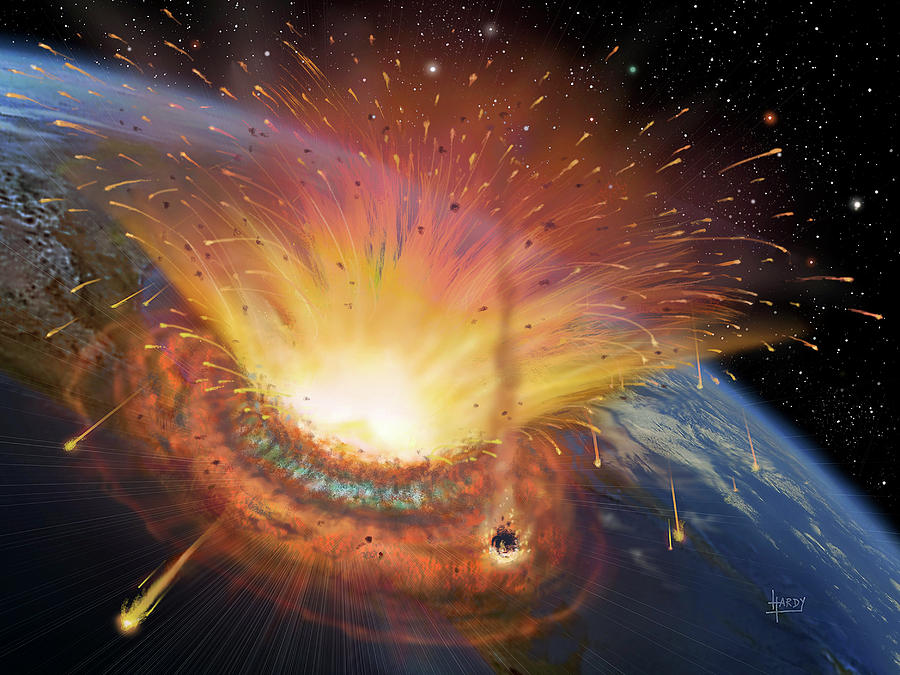Mar
3
The Impact of the Chicxulub Asteroid
This is the last citation from Hugh Ross’s Improbable Planet, I promise.
In this excerpt, Ross discusses the impact (in both senses of the term) of the Chicxulub asteroid, which struck the Yucatán Peninsula and caused the Cretaceous-Paleogene Extinction. In short, it was much worse than originally thought.
— — —

The decisive blow that wiped out the already critically stressed species came from the asteroid that produced the Chicxulub impact crater in Mexico. The established date for the impact event is 66.038 +/- 0.049 (including systematic and random uncertainties) million years ago, which is virtually identical to the date for the Cretaceous-Paleogene Extinction Event (CPEE). The crater measures 180-200 kilometers (112-124 miles) across and about 20 kilometers (12-13 miles) deep. Based on these measurements, geophysicists deduce that the asteroid’s diameter was 10 kilometers (6 miles) or more. The calculated impact energy equaled 100 terratonnes [sic] of TNT, the equivalent of 3 billion times the combined energy of the atomic bombs dropped on Hiroshima and Nagasaki.
For two decades after the Chicxulub asteroid impact crater was discovered in the 1970s, researchers debated its ecological consequences, but the debate continues no longer. In a review article published in Science in March 2010, an interdisciplinary team of 41 distinguished scientists concluded that the impact produced these effects:
- It generated a shock wave and a heat wave that instantly killed all surface life within a diameter of several thousand miles from the impact site.
- It induced multiple earthquakes of magnitude 11 and greater.
- It unleashed tsunamis cresting above 100 meters (328 feet) that crashed upon all Atlantic Ocean coastlines and rushed an average of 20 kilometers (12 miles) inland.
- It produced enough nitric oxide (NO) from shock-heated air to destroy the ozone shield.
- It acidified the surface waters of all oceans, seas, and lakes.
- It released, almost instantaneously, more than 500 billion tonnes (550 billion tons) of sulfur into the atmosphere.
- It transformed most of the released sulfur into sulfur aerosols that blocked sunlight.
- It proliferated enough dust, sulfur aerosols, and smoke (from fires ignited by ballistic ejecta as they reentered the atmosphere) to shut down photosynthesis for a few years.
- It killed off all herbivores and carnivores dependent upon photosynthetic organisms for food.
- It dropped the global mean temperature, due to sunlight blockage, by up to 10oC (18oF) for years, perhaps decades.
Discoveries since the publication of this review article show that the end-Cretaceous mass extinction was much more severe than previously thought. High-precision argon-40/argon-39 dating has established that the Deccan supervolcanoes underwent much-accelerated eruptions at the same time as the Chicxulub asteroid impact. Seismic modeling shows that ground motion from the Chicxulub impactor would have triggered volcanic eruptions worldwide and would have sustained the eruption of lava, dust, and gas from supervolcanoes for millennia.
A five-meter (16.5 feet) thick tsunami deposit on the Dalmatian island of Hvar in the Adriatic Sea has the same elemental isotope signature as Chicxulub impact deposit material. Such a large tsunami deposit so far away from the impact site sustains the conclusion that the Chicxulub impact event drove to extinction at least 75 percent of Earth’s species. Paleothermometry of ocean sediments establishes a worldwide severe ocean surface temperature drop during the months following the impact event, a plunge caused by dust blocking out solar radiation.

Recent fossil record research demonstrates that paleontologists had underestimated species extinctions resulting from the Chicxulub impactor. Small lizards and snakes, which had been presumed to have largely survived the event, actually suffered an extinction rate of 83 percent. One hundred percent of ammonites and more than 90 percent of calcareous nannoplankton and foraminifera went extinct.
A fungal spike (global fungal proliferation) that persisted for several years following the CPEE indicates that as surface-swelling herbivores and carnivores died out, surface-dwelling detritivores (organisms that feed on dead organisms) thrived. Post-impact fossils recovered near the Boltysh crater (24 kilometers in diameter) in Ukraine — an impact dated to have occurred within a few hundred thousand years of the impact that formed the Chicxulub crater — reveal that climatic oscillations after the initial impact likely delayed vegetation recovery by many more years due to a lack of moisture.
Although the CPEE wiped out 75 percent or more of all species on Earth, the recovery proved both quick and robust, much like that from the [Triassic-Jurassic Extinction Event]. The Paleogene mass speciation event took full advantage of changes in the Earth’s climate and geography….
— — —
But, to get the rest of that story — which involves the Antarctic Circumpolar Current, the explosive appearance of widely diverse angiosperm species, an equally explosive emergence of diverse insects, and the proliferation of new large- and small-bodied mammals, et al. — you’ll have to get the book. 🙂 (And, yes, if you purchase through one of my affiliate links, I’ll earn a few cents — which will go toward more books, of course.)
Let me know if you have enjoyed these glimpses into our “improbable planet” and its naturalism-defying design.















